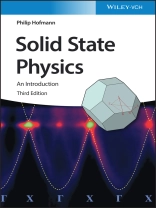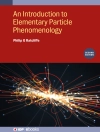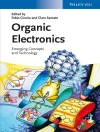Solid State Physics
Enables readers to easily understand the basics of solid state physics
Solid State Physics is a successful short textbook that gives a clear and concise introduction to its subject. The presentation is suitable for students who are exposed to this topic for the first time. Each chapter starts with basic principles and gently progresses to more advanced concepts, using easy-to-follow explanations and keeping mathematical formalism to a minimum.
This new edition is thoroughly revised, with easier-to-understand descriptions of metallic and covalent bonding, a straightforward proof of Bloch’s theorem, a simpler approach to the nearly free electron model, and enhanced pedagogical features, such as more than 100 discussion questions, 70 problems – including problems to train the students’ skills to find computational solutions – and multiple-choice questions at the end of each chapter, with solutions in the book for self-training.
Solid State Physics introduces the readers to:
- Crystal structures and underlying bonding mechanisms
- The mechanical and vibrational properties of solids
- Electronic properties in both a classical and a quantum mechanical picture, with a treatment of the electronic phenomena in metals, semiconductors and insulators
- More advanced subjects, such as magnetism, superconductivity and phenomena emerging for nano-scaled solids
For bachelor’s students in physics, materials sciences, engineering sciences, and chemistry, Solid State Physics serves as an introductory textbook, with many helpful supplementary learning resources included throughout the text and available online, to aid in reader comprehension.
Зміст
Preface to the First Edition xi
Preface to the Second Edition xiii
Preface to the Third Edition xv
Physical Constants and Energy Equivalents xvii
1 Crystal Structures 1
1.1 General Description of Crystal Structures 2
1.2 Some Important Crystal Structures 3
1.2.1 Cubic Structures 4
1.2.2 Close-Packed Structures 5
1.2.3 Structures of Covalently Bonded Solids 6
1.3 Crystal Structure Determination 7
1.3.1 X-Ray Diffraction 7
1.3.1.1 Bragg Theory 7
1.3.1.2 Lattice Planes and Miller Indices 8
1.3.1.3 General Diffraction Theory 9
1.3.1.4 The Reciprocal Lattice 11
1.3.1.5 The Meaning of the Reciprocal Lattice 12
1.3.1.6 X-Ray Diffraction from Periodic Structures 14
1.3.1.7 The Ewald Construction 15
1.3.1.8 Relation Between Bragg and Laue Theory 16
1.3.2 Other Methods for Structure Determination 17
1.3.3 Inelastic Scattering 17
1.4 Further Reading 17
1.5 Discussion and Problems 18
Discussion 18
Basic Concepts 18
Problems 20
2 Bonding in Solids 23
2.1 Attractive and Repulsive Forces 23
2.2 Ionic Bonding 24
2.3 Covalent Bonding 25
2.4 Metallic Bonding 32
2.5 Hydrogen Bonding 33
2.6 Van der Waals Bonding 33
2.7 Further Reading 34
2.8 Discussion and Problems 34
Discussion 34
Basic Concepts 35
Problems 35
3 Mechanical Properties 37
3.1 Elastic Deformation 39
3.1.1 Macroscopic Picture 39
3.1.1.1 Elastic Constants 39
3.1.1.2 Poisson’s Ratio 40
3.1.1.3 Relation Between Elastic Constants 40
3.1.2 Microscopic Picture 41
3.2 Plastic Deformation 43
3.2.1 Estimate of the Yield Stress 43
3.2.2 Point Defects and Dislocations 45
3.2.3 The Role of Defects in Plastic Deformation 45
3.3 Fracture 47
3.4 Further Reading 48
3.5 Discussion and Problems 48
Discussion 48
Basic Concepts 49
Problems 49
4 Thermal Properties of the Lattice 51
4.1 Lattice Vibrations 51
4.1.1 A Simple Harmonic Oscillator 51
4.1.2 An Infinite Chain of Atoms 52
4.1.2.1 One Atom Per Unit Cell 52
4.1.2.2 The First Brillouin Zone 55
4.1.2.3 Two Atoms per Unit Cell 56
4.1.3 A Finite Chain of Atoms 58
4.1.4 Quantized Vibrations, Phonons 59
4.1.5 Three-Dimensional Solids 61
4.1.5.1 Generalization to Three Dimensions 61
4.1.5.2 Estimate of the Vibrational Frequencies from the Elastic Constants 63
4.2 Heat Capacity of the Lattice 64
4.2.1 Classical Theory and Experimental Results 65
4.2.2 Einstein Model 66
4.2.3 Debye Model 68
4.3 Thermal Conductivity 71
4.4 Thermal Expansion 74
4.5 Allotropic Phase Transitions and Melting 75
References 78
4.6 Further Reading 78
4.7 Discussion and Problems 78
Discussion 78
Basic Concepts 79
Problems 81
5 Electronic Properties of Metals: Classical Approach 85
5.1 Basic Assumptions of the Drude Model 85
5.2 Results from the Drude Model 87
5.2.1 dc Electrical Conductivity 87
5.2.2 Hall Effect 89
5.2.3 Optical Reflectivity of Metals 90
5.2.4 The Wiedemann–Franz Law 93
5.3 Shortcomings of the Drude Model 93
5.4 Further Reading 94
5.5 Discussion and Problems 95
Discussion 95
Basic Concepts 95
Problems 96
6 Electronic Properties of Solids: Quantum Mechanical Approach 99
6.1 The Idea of Energy Bands 100
6.2 The Free Electron Model 103
6.2.1 The Quantum-Mechanical Eigenstates 103
6.2.2 Electronic Heat Capacity 107
6.2.3 The Wiedemann–Franz Law 108
6.2.4 Screening 108
6.3 The General Form of the Electronic States 111
6.4 Nearly-Free Electron Model: Band Formation 114
6.5 Tight-binding Model 119
6.6 Energy Bands in Real Solids 124
6.7 Transport Properties 130
6.8 Brief Review of Some Key Ideas 134
References 135
6.9 Further Reading 135
6.10 Discussion and Problems 136
Discussion 136
Basic Concepts 137
Problems 140
7 Semiconductors 145
7.1 Intrinsic Semiconductors 146
7.1.1 Temperature Dependence of the Carrier Density 148
7.2 Doped Semiconductors 153
7.2.1 n and p Doping 153
7.2.2 Carrier Density 155
7.3 Conductivity of Semiconductors 157
7.4 Semiconductor Devices 158
7.4.1 The pn Junction 158
7.4.2 Transistors 163
7.4.3 Optoelectronic Devices 165
7.5 Further Reading 168
7.6 Discussion and Problems 169
Discussion 169
Basic Concepts 170
Problems 172
8 Magnetism 175
8.1 Macroscopic Description 175
8.2 Quantum-Mechanical Description of Magnetism 177
8.3 Paramagnetism and Diamagnetism in Atoms 179
8.4 Weak Magnetism in Solids 182
8.4.1 Diamagnetic Contributions 183
8.4.1.1 Contribution from the Atoms 183
8.4.1.2 Contribution from the Free Electrons 183
8.4.2 Paramagnetic Contributions 183
8.4.2.1 Curie Paramagnetism 184
8.4.2.2 Pauli Paramagnetism 185
8.5 Magnetic Ordering 187
8.5.1 Magnetic Ordering and the Exchange Interaction 187
8.5.2 Magnetic Ordering for Localized Spins 189
8.5.3 Magnetic Ordering in a Band Picture 193
8.5.4 Ferromagnetic Domains 195
8.5.5 Hysteresis 196
Reference 198
8.6 Further Reading 198
8.7 Discussion and Problems 199
Discussion 199
Basic Concepts 200
Problems 201
9 Dielectrics 203
9.1 Macroscopic Description 203
9.2 Microscopic Polarization 205
9.3 The Local Field 207
9.4 Frequency Dependence of the Dielectric Constant 208
9.4.1 Excitation of Lattice Vibrations 208
9.4.2 Electronic Transitions 212
9.5 Other Effects 213
9.5.1 Impurities in Dielectrics 213
9.5.2 Ferroelectricity 214
9.5.3 Piezoelectricity 215
9.5.4 Dielectric Breakdown 216
9.6 Further Reading 216
9.7 Discussion and Problems 216
Discussion 216
Basic Concepts 217
Problems 218
10 Superconductivity 221
10.1 Basic Experimental Facts 222
10.1.1 Zero Resistivity 222
10.1.2 The Meissner Effect 225
10.1.3 The Isotope Effect 227
10.2 Some Theoretical Aspects 227
10.2.1 Phenomenological Theory 227
10.2.2 Microscopic BCS Theory 230
10.3 Experimental Detection of the Gap 236
10.4 Coherence of the Superconducting State 238
10.5 Type-I and Type-II Superconductors 239
10.6 High-Temperature Superconductivity 242
10.7 Concluding Remarks 243
References 244
10.8 Further Reading 244
10.9 Discussion and Problems 244
Discussion 244
Basic Concepts 245
Problems 246
11 Finite Solids and Nanostructures 249
11.1 Quantum Confinement 250
11.2 Surfaces and Interfaces 252
11.3 Magnetism on the Nanoscale 255
11.4 Further Reading 256
11.5 Discussion and Problems 257
Discussion 257
Basic Concepts 257
Problems 257
Appendix A 259
A.1 Explicit Forms of Vector Operations 259
A.2 Differential Form of the Maxwell Equations 260
A.3 Maxwell Equations in Matter 261
Appendix B 263
B.1 Solutions to Basic Concepts Questions 263
Index 265
Про автора
Philip Hofmann studied physics at the Free University, Berlin and did his Ph D research at the Fritz-Haber-Institute of the Max Planck Society, also in Berlin. He stayed at the Oak Ridge National Laboratory, USA, as a Feodor Lynen Fellow of the Alexander von Humboldt Foundation. In 1998, he moved to Aarhus University, Denmark, where he is a professor at the Department of Physics and Astronomy.












